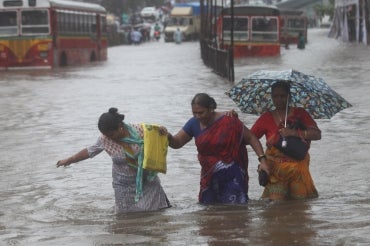U of T expert 'somewhat optimistic' about UN climate summit

Published: November 6, 2017
The UN climate change conference, otherwise known as COP23, kicked off in Bonn, Germany today with governments working toward a “rule book” to guide the implementation of the Paris Agreement, even as the United States has backed out of the pact.
Against the backdrop of extreme weather events like floods, hurricanes and wildfires this year, the summit, which runs from Nov. 6-17, will be presided over by Fiji's prime minister Frank Bainimarama, who has said he wants more urgent action to cut greenhouse gases. Fiji, one of the small island nations most at risk from the rise of sea levels and extreme storms, suffered over $1 billion in damages after a cyclone struck last year.
The 2015 Paris Agreement, the world's first deal to tackle climate change together, had set a goal of keeping global temperature rise to well below 2 degrees Celsius, and 1.5 degrees Celsius if possible.
Matthew Hoffmann, professor of political science at U of T Scarborough and co-director of the Environmental Governance Lab at the Munk School of Global Affairs, says the world is not on track.
“Implementation of the pledges already made and ratcheting up of those pledges over time (and relatively quickly) will now need to be the focus of attention,” he says.
How is the world doing when it comes to meeting targets? Are we in the 2 degrees Celsius limit?
No, unfortunately not. The United Nations Environment Program just came out with its emissions gap report and the headline is that the world is not on track for achieving the 2-degree goal. In fact, the report states that what has been pledged so far is only about one-third of what we need to do. This is not a surprise as the pledges countries made at Paris were never thought to be sufficient to reach the long term goal. They were always supposed to be just a down payment and the start of the process of moving towards decarbonization.
Implementation of the pledges already made and ratcheting up of those pledges over time (and relatively quickly) will now need to be the focus of attention.
With Trump backing out of the Paris Agreement, is the U.S. even sending reps to the summit? Is there any point in having a U.S. presence there if the president does not believe in global warming?
Yes, the U.S. will still send representatives to the Bonn climate meetings. The U.S. is still a party to the Paris Agreement and won't officially begin the process of pulling out until 2019. Unfortunately one reason the U.S. is going is to push its anti-climate action agenda. There have been reports in the media that the U.S. will be touting 'clean' coal and natural gas – fossil fuels responsible for causing climate change – at the international negotiations.
Which countries with high emissions are not doing as good a job meeting targets? Who is doing a good job?
Given that the Paris Agreement has only been in force for a year, it is a bit early to tell on both the good and bad sides. In part, the climate meetings this year are an opportunity for the international community to discuss how they will monitor and review what countries are doing.
In general though, Germany and the Scandinavian countries are moving very quickly on the renewable energy front. China appears to be moving very quickly on its goal of having emissions peak by 2030 – in fact, by some estimates, they already have. The U.S. has a decent chance of meeting their 2030 targets even with the Trump administration's recalcitrance because of a range of actions being taken by states and cities. Canada's environment commissioner gave the federal government a poor grade for moving towards our Paris targets, but many of the policies that are designed to help Canada meet its target are only slated to come on line in the next few years.
An assessment of countries' pledges and activities to meet those pledges can be found here.
When they say that a priority for the summit is firming up the 2015 Paris Agreement, what does that mean?
This year's negotiations are focused on discussing what is being called the Paris rule book – the processes and procedures that countries will follow around transparency, monitoring and verification of their pledges, plans and implementation actions. They will also discuss how to undertake the global stocktake – the assessment of the cumulative impact of the actions being undertaken and what needs to be done to keep moving towards the Paris goals.
What are challenges ahead? What do you expect to come out of the new agreement?
I do not have high expectations for this year's meetings in terms of a major agreement. This will be the start of the process by which the international community figures out how to make the Paris Agreement work, and I suspect that it will take more than one summit to hammer out. These will be tough discussions – countries have very different ideas about and interests in transparency and monitoring of their climate policies and actions. Plus, the U.S. presence promises to be a distraction. However, there still seems to be a remarkable consensus (outside the U.S.) on the need to keep pushing, so I am somewhat optimistic about the possibilities for some progress at this summit.



